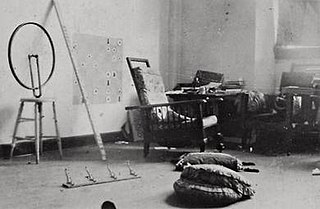Loading AI tools
Series of artworks by Marcel Duchamp From Wikipedia, the free encyclopedia
The readymades of Marcel Duchamp are ordinary manufactured objects that the artist selected and modified, as an antidote to what he called "retinal art".[1] By simply choosing the object (or objects) and repositioning or joining, titling and signing it, the found object became art.

Duchamp was not interested in what he called "retinal art"—art that was only visual—and sought other methods of expression. As an antidote to retinal art he began creating readymades in 1914, when the term was commonly used in the United States to describe manufactured items to distinguish them from handmade goods.
He selected the pieces on the basis of "visual indifference",[2] and the selections reflect his sense of irony, humor and ambiguity: he said "it was always the idea that came first, not the visual example ... a form of denying the possibility of defining art."
The first definition of "readymade" appeared in André Breton and Paul Éluard's Dictionnaire abrégé du Surréalisme: "an ordinary object elevated to the dignity of a work of art by the mere choice of an artist". While published under the name of Marcel Duchamp (or his initials, "MD", to be precise), André Gervais nevertheless asserts that Breton wrote this particular dictionary entry.[3]
Duchamp only made a total of 13 readymades over a period of time of 30 years.[4] He felt that he could only avoid the trap of his own taste by limiting output, though he was aware of the contradiction of avoiding taste, yet also selecting an object. Taste, he felt, whether "good" or "bad", was the "enemy of art".[5]
His conception of the readymade changed and developed over time. "My intention was to get away from myself", he said, "though I knew perfectly well that I was using myself. Call it a little game between 'I' and 'me'".[6]
Duchamp was unable to define or explain his opinion of readymades: "The curious thing about the readymade is that I've never been able to arrive at a definition or explanation that fully satisfies me."[7] Much later in life Duchamp said, "I'm not at all sure that the concept of the readymade isn't the most important single idea to come out of my work."[1]
Robert Fulford described Duchamp's readymades as expressing "an angry nihilism".[8]
By submitting some of them as art to art juries, the public, and his patrons, Duchamp challenged conventional notions of what is, and what is not, art. Some were rejected by art juries and others went unnoticed at art shows.
Most of his early readymades have been lost or discarded, but years later he commissioned reproductions of many of them.

(Note: Some art historians consider only the un-altered manufactured objects to be readymades. This list includes the pieces he altered or constructed.)

In 1964, Duchamp authorized a limited edition release of replicas of fourteen of his readymades to be issued by his art dealer, Arturo Schwarz, through the Galleria Schwarz in Milan. The edition included eight sets for sale, two sets of artist's proofs (one for Duchamp and one for Schwarz), and two hors de commerce sets to be given to museums.[18] Schwarz replicated the works with oversight from Duchamp, taking "almost fanatical care" in reproducing them accurately, according to Duchamp.[19][20]
Critical reaction to Duchamp's decision to reproduce the readymades was generally negative. Artist Daniel Buren, for example, said that Duchamp had "sold out to commercialism".[21] As decades passed, however, the Galleria Schwarz replicas "gradually became mainstreamed and eventually became stand-ins for the lost originals, sharing their status and value", according to scholar Adina Kamien-Kazhdan.[22] Today, Schwarz's replicas are found in museums around the world.
Initial demand for the replicas was slow. One set was sold in 1969 to New York art dealer Arne Ekstrom, who then sold it to Indiana University Art Museum in 1971 for $35,000.[23] Another set was sold in 1971 to the National Gallery of Canada.[23] By 1974, much of the edition was still unsold, though Schwarz had raised the prices considerably; a complete set was listed for $450,000, and individual works started at $15,000.[24] Schwarz sold his remaining inventory at auction in 1985, except for one remaining complete set, which he sold to the National Museum of Modern Art in Japan in 1987.[25]
Duchamp's proof set was sold by his widow to the Musée National d'Art Moderne in Paris in 1986.[26] Schwarz sold his proof set at auction in 2002.[27][28] The two museum sets were donated to the Israel Museum in Jerusalem in 1972 and the National Gallery of Modern Art in Rome in 1997.[29]
Research published in 1997 by Rhonda Roland Shearer questions whether Duchamp's "found objects" may actually have been created by Duchamp.[30] Her research of items like snow shovels and bottle racks in use at the time failed to turn up any identical matches to photographs of the originals. However, there are accounts of Walter Arensberg and Joseph Stella being with Duchamp when he purchased the original Fountain at J. L. Mott Iron Works. Such investigations are hampered by the fact that few of the original "readymades" survive, having been lost or destroyed. Those that still exist are predominantly reproductions authorized or designed by Duchamp in the final two decades of his life. Shearer also asserts that the artwork L.H.O.O.Q. which is recorded to be a poster-copy of the Mona Lisa with a moustache drawn on it, is not the true Mona Lisa, but Duchamp's own slightly-different version that he modelled partly after himself. The inference of Shearer's viewpoint is that Duchamp was creating an even larger joke than he admitted.[31]
Seamless Wikipedia browsing. On steroids.
Every time you click a link to Wikipedia, Wiktionary or Wikiquote in your browser's search results, it will show the modern Wikiwand interface.
Wikiwand extension is a five stars, simple, with minimum permission required to keep your browsing private, safe and transparent.